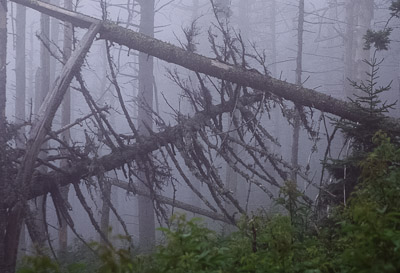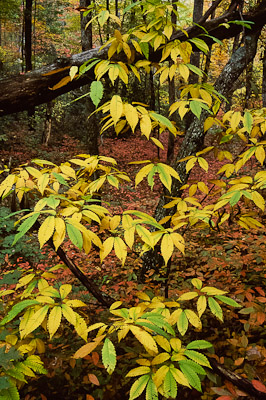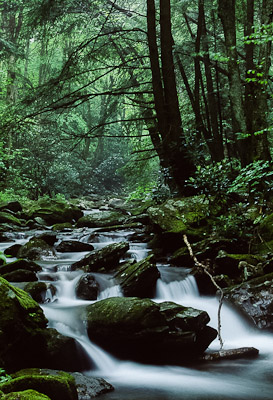Ninth Life for Natives? How Exotic Pests Are Changing the Mountain Landscape
[originally published September/October 2002 Blue Ridge Country]
In February 1999, President Clinton signed an Executive Order to combat a major environmental problem. "[N]ow is the time to take action," remarked Interior Secretary Bruce Babbit. "The costs to habitats and the economy are racing out of control."
This was good news for the Appalachians, though the order didn't deal with urban sprawl, hydrocarbons, low-level ozone, buffer zones, or timber sales. "Biopollution" would be a new word for plenty of Americans, but it could also threaten native plants and animals more than anything except habitat loss.
Since 1492, more than 50,000 organisms have been brought to the New World from the rest of the world. Though most are harmless or beneficial, the small minority run rampant coast to coast, disrupting agriculture, killing forests, driving out native species, and costing the U.S. an estimated $137 billion each year.
The Blue Ridge has taken its share of hits in the last century. Biological invaders have little respect for the arbitrary borders that define our wilderness areas so effectively on maps. It's no surprise that the quiet loss of native organisms doesn't draw the same attention as valley smog or cell towers: an ecosystem that looks healthy at a glance may have been altered by exotics long ago.
Growing up in rural western North Carolina, I never guessed that all those yummy tangles of honeysuckle penetrating woodpiles and fencerows originally came from Japan. The multiflora rose that smelled nice but smothered the edge of our woods is also an escapee from Asia. Conversely, I never missed natives like American elm or American chestnut - they'd been gone long before I got here, succumbed to diseases from the other side of the world.
Our current generation is in the unwelcome position of watching gypsy moths defoliate oaks, starry sky beetles destroy maples, balsam woolly adelgids kill Fraser firs, anthracnose wipe out dogwoods, wild hogs trample plants and streams, and brown and rainbow trout displace native brookies. If your favorite native doesn't show up on this list, there's always a chance it will make the next one.
 |
Fraser firs, killed in part by adelgids, on Mt. Mitchell, NC. |
While debates rage over cloning and genetic engineering, the spread of exotics violates basic biology on a far grander scale. Before the Age of Exploration, ecosystems evolved in isolation, separated by everything from mountains and rivers to the splitting of the continents 100 million years ago. It's hard for humans, living threescore and ten, to fully appreciate the eons of independent selection that gave each community a unique, fragile balance of predator and prey, resource allocation, and disease resistance, without which any species could monopolize territory just by steadily reproducing itself. In the old days, this wasn't an issue -- the sudden introduction of new organisms, whether caused by wind, waves, or their own feet, were comparatively few and far between.
These days, species from across the globe can become instant neighbors thanks to ballast-water dumped from ships, fill-dirt brought cross-country, international trade of plants and animals, and seeds or spores that hitch rides from planes, trains, and automobiles. So many introductions are taking place that the fact only 1% turn critical is cold comfort. If that earlier figure of $137 billion sounds exaggerated, consider that the exotic Formosan termite does $300 million in damage just in New Orleans, or that leafy spurge costs farmers, ranchers, and taxpayers $144 million dollars in four western states alone.
Ecologist Gordon Orian may be right to dub our epoch of global blending the "Homogocene," and future world travelers may find more than just the hotels and restaurants looking the same. Many environmental sins of previous generations are atoned and forgotten, but we could pay forever for old mistakes with exotics. Surely every Southerner can appreciate the irony of a 1930s Soil Conservation Service decision to pay farmers to plant some 85 million kudzu seedlings for erosion control.
 |
Chestnut sapling, before succumbing to blight, North Mills River area, NC. |
The rising tide of exotics fully caught my attention through one of my favorite native organisms, the Eastern hemlock. "Stately" is a cliché for trees, but the hemlock is worthy of the word. Growing from 2,000-foot valley coves up to the 5,000-foot realm of spruce, they keep color in the winter woods. They feed and protect deer, squirrels, chipmunks, and over ninety different songbirds, and they shade streams for brook trout. Undisturbed, they've grown 160 feet tall and almost 1,000 years old. Now, they could disappear thanks to yet another exotic insect, the hemlock woolly adelgid.
This adelgid was imported to the West Coast in the 1920s, this time from Asia. Spotted in Virginia in the 1950s, it has spread rapidly on both Eastern hemlock and the less common Carolina hemlock. Like the balsam woolly adelgid, it sucks sap and stunts growth until the host calls it quits. In Asia, there were natural predators; here, it has no opposition, particularly in natural forests where chemical controls are impractical.
The insect has plagued Shenandoah National Park's small but remarkable hemlock population for more than a decade. It also shocked scientists when it recently appeared in sections of the Great Smokies, where old-growth stands weren't expected to be threatened until 2010. As a Forest Service publication has coolly summarized the situation: "The hemlock woolly adelgid will continue to spread . . . causing devastation of the hemlock resource in its wake. Many entomologists fear the worst for both Eastern and Carolina hemlock, believing that HWA holds the potential for wiping out both tree species."
In the years since, we've been given just one good reason to hope otherwise. The paradoxical use of one exotic to control another has worked with earlier pests, such as when the Vedalia beetle was brought from California to control Australian cottony cushion scale in North Carolina. (After killing the scale, the beetle itself kindly died out, having depleted its food supply.) In the end, native hemlocks may be at least partially saved by a predatory beetle from Japan, formerly undescribed by entomologists.
Drs. Mark McClure and Hiroyuki Sasaji named the new insect Pseudoscymnus tsugae after McClure collected it throughout Honshu, where it was eliminating 86 to 99 percent of native adelgid populations. Back home, McClure and his team carefully introduced the beetle to field plots on a Connecticut experiment station. Early results were encouraging: P. tsugae spontaneously moved from hemlock to hemlock, survived both harsh and mild winters, multiplied in number, and, best of all, consumed 70 to 100 percent of exotic adelgids without damaging other organisms. McClure's lab and other agencies have since raised and released hundreds of thousands of adult beetles for ongoing trials in ten states.
"It is not hard to get excited about a biocontrol agent that displays so many of the desirable characteristics scientists select for when screening potential biocontrol candidates," writes Brad Onken of the Forest Service. But Onken also points out that P. tsugae is probably not "the 'silver bullet' that will save our hemlock forests . . . it is uncommon for an individual predator to control a forest pest single-handedly." Some scientists continue to study different species of beetles and fungi as control agents, while others work to produce adelgid-resistant hemlock hybrids. Any workable solutions could take years to begin working in whole forests.
That's why some researchers continue to study the variety of seeds and spores occurring in hemlock stands - if all efforts fail, including P. tsugae, at least we'll know what may take the big trees' place.
 |
Mineral Creek, Craggy Mountains, NC, shaded by old eastern hemlocks. |
The continuing struggle with hemlock woolly adelgid characterizes the invasive species problem and begs the question: Wouldn't it be simpler to keep exotics off native organisms to begin with, rather than scouring pests' home ecosystems after the fact, with the uncertain hope of finding natural predators that must then be transported to North America, raised en masse, introduced to secure but natural ecosystems, and studied through years of droughts, temperature fluctuations, and other variables that could potentially confuse data - none of which may keep the invader from killing its host anyway?
The catch-22 with most harmful exotics is that an ounce of prevention is worth tons of cure, but prevention is never easy, or popular. Historically, potentially invasive exotics have been fought primarily on paper. In the words of ecologist Daniel Simberloff, federal laws are "only invoked after a species is already in the U.S. - in other words, too late." Underfunded, understaffed agencies can't keep up with invasives not only coming into the country, but spreading between states as well.
Things are similar on the international level. Several laws and treaties address invasives, but not with the firm precautionary stance required for an increasingly global society. Instead, ecological concerns get a polite nod while governments balk at doing anything that might hinder free trade.
Clinton's Executive Order of February '99 promised a more aggressive approach for the U.S. by directing relevant federal agencies to crack down on risky introductions, and by creating an Invasive Species Council co-chaired by the Secretaries of the Interior, Agriculture, and Commerce. Much of the Council's initial work was simply organizing the 20 existing agencies plus offices from all 50 states into a unified force against organisms that have a natural disregard for jurisdictional borders.
Future directives call for rapid response teams, networks of scientists, and informed community groups working quickly to identify, prevent or reverse potential "invasions" before (if possible) they get totally out of hand. In the Blue Ridge, that could mean ongoing efforts to eliminate new pests like hemlock woolly adelgid, contain old outbreaks of kudzu and multiflora rose, and keep a sharper eye on traffic with the rest of the world's temperate zones.
All this sounds encouraging, but most of the plans were, of course, developed before September 11, 2001. Even then, writing the first draft of this article in November 2000, I concluded on a low note, citing lack of public awareness and political initiative as major impediments to real-world action. Progress has since been predictably slow, and whether our current world situation will allow a long and expensive war on exotic species is very much in question.
©Stephen Schoof